-
Mar 21, 2019, 08:44 PM
#11
Matt I just want to say Bravo and thank you for all of your work on this. Fascinating stuff really.
-
Post Thanks / Like - 1 Likes
 Matt
Matt liked this post
-
Mar 23, 2019, 05:15 PM
#12
Watches on the summit of Everest in 1953, the final and definitive answer.
After a lot of research and following a series of recent (and ancient) discussions here and in several other forums, I think I'm finally in a position to give a tidy and definitive answer to this question. The fact is that the 1953 Everest expedition was equipped with watches from both Rolex and Smiths. These were distributed unevenly across the team, with some members ending up with multiple watches and others ending up with a single watch. In addition to this, Rolex gave watches to several members of the expedition before and after the successful ascent. They also advertised heavily, and in ways that appear to be designed to be misconstrued in Rolex favour, from the moment the news broke to the present day. This has caused confusion for over seventy years and has allowed a lot of misleading, and downright false, stories to circulate, percolate and become close to common knowledge.
In this thread, my intention is to demonstrate through a series of primary photographic and documentary sources, combined with deduction from those sources, that there were only two watches carried to the summit and that both of those watches were custom made Smiths, identified as the 'A409' by Smiths, but actually an amalgam of the Smiths A404 'Tropical' case by Dennison, the Smiths Cal.40 '1215' movement and a custom made dial with shaded numerals that shared elements of the Benson Tropical and the Smiths A404. To put it another way, the watches were standard Early Smiths A404 (with 18mm lugs) but with a custom dial and special preparation. One of these watches, Hillary's, is in The Science Museum in London.
There were two attempts to reach the summit. The first, by Charles Evans and Tom Bourdillon, failed; the sufficient cause of their failure was the failure, due to ice, of their oxygen systems, these were an experimental setup, designed by Bourdillon himself (who really was a Farnborough rocket scientist!) the system was known to be troublesome but was infinitely more efficient and economical when working. HIllary and Norgay used an open breather system that was substantially unchanged from the system used by Mallory in 1954.
Both Evans and Bourdillon wore Rolex 6098 watches. These were a standard Rolex model available commercially at the time which combined an A296 winding module with a Cal.765 movement in a 35.5mm 'Big Bubbleback' case. Bourdillon's and Evans' can be clearly identified in photographs of them during the expedition and on their return to camp IV after the failed attempt. Evans' has surfaced in the public domain and pictures of it are all over the internet. Had they succeeded, it is clear that the watch on the summit would have been a standard Rolex 6098 with a white pointed baton dial. Rolex's advertising department would have had a field day.
They didn't. The rest is history.
I'm going to divide this post into two halves. First I intend to demonstrate that there was no Rolex on the summit of Everest in 1953. Obviously, proving a negative is notoriously difficult and, many would say, impossible. However, I reckon I'll have a go. The latter half of this section relies extensively on documents dug out of the BHI archives by Broussard over at TZ- UK, who really deserves the credit for the evidence at the heart of that segment of my argument.
Everest's summit was reached on the 29th of May at 11:30 am local (Nepal is six hours ahead +BST making it 6:30pm in London). The expedition was equipped with heavy, low powered short range radios. The summit party were not carrying them and did not contact anyone until they met Lowe near Camp IV some five hours later. At this point, base camp was contacted and James Morris, the correspondent for the Times (who had a binding copyright deal with the Royal Geographical Society that had been rigorously enforced) made his way down the Mountain and back across the treacherous Khumbu glacier with Mike Westmacott. They then contracted a local runner to carry the message to an Indian Army outpost at Namche Bazaar some twenty miles away. At this point, people at the base of the mountain began to discover that Everest had been conquered, but no one but Morris and Westmacott knew by whom. To ensure this secrecy, Morris had arranged a series of elaborate codes to identify the climbers who had reached the summit.
However, there's an added detail that gives us an idea of just how important this climb was to Rolex. Rolex's ad agency at the time, J Walter Thompson, had assigned, and apparently wangled journalist's credentials for, a young and talented advertising executive, Ayaz Peerbhoy, to respond to precisely this information. Unlike the other journalists saving their runners for a scoop to file, Peerbhoy was only interested in two facts: that there had been no tragedy and the expedition had succeeded. This was all that was needed to place a triumphant advert in the Times and Rolex and a couple of other JWT clients got the drop on everyone. Both Peerbhoy's and Morris' messages arrived in London late on the first and allowed Rolex to run the now famous strapline on page three - the first page of the Times that carried adverts that day - of the Times on the morning of the second of June:

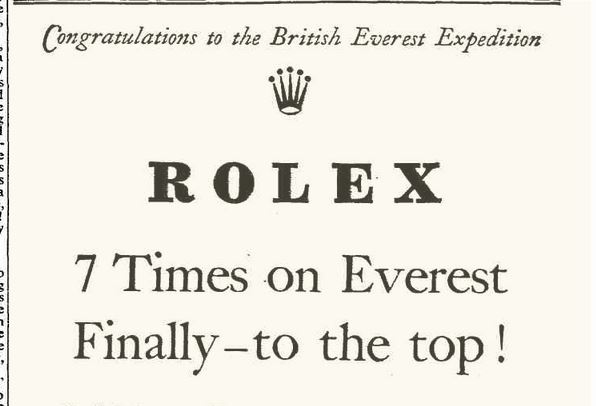
This is one of the very few adverts that ever explicitly claims that Rolex were worn on the summit.
However, it claims it repeatedly and clearly in full expectation that the claim will be proven to be correct.
The '7 times on Everest' headline does not refer to the climbers, but to the number of expeditions on which
at least one Rolex had been carried, which is an impressive level of vaunt. However, as I demonstrated
elsewhere, until the fifties, as far as I can ascertain, this was usually just the 1920s cushion cased
Oyster owned by Eric Shipton. It's possible and certainly in line with Wilsdorf's product placing philosophy
that this was a gift, but it could just as well be coincidence and opportunism from Rolex.

The graphic at the bottom of the advert is utterly unambiguous. There's no doubt at any point: Rolex had a long and
central role in the exploration and conquering of Everest and was on the summit with Tenzing and Hillary.
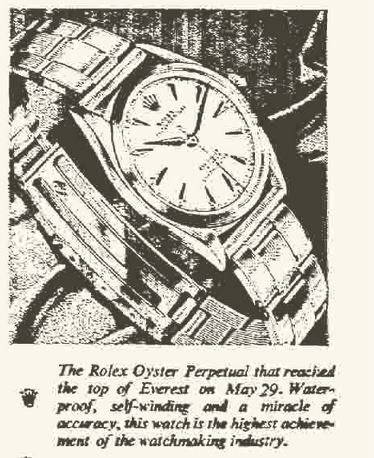
On the second of June, Smiths were quick enough to get in a carefully worded and sober advert -
on page four - that took no risks that the triumph might be tinged with disaster:

And it was only the next day, the third, that, having read the Times exclusive, they felt able to run a more triumphant advert:

On the face of it, this was a triumph for Rolex. Peerbhoy accompanied the victorious mountaineers to Calcutta where Bosecks Jewellers were remarkably generous to the heroic team, wrote much of the copy that is now so well known, and was given a solid gold Rolex for his role in what looked at the time like an unambiguous advertising coup for Rolex. However, after a few months and some equally gold plated advertising, this rosy picture started to sour.
Half way through this first section, I'd like to pause and take stock. It's very clear that getting a Rolex to the top of Everest first is extremely important to Rolex. They had their response in place and, through their ad agency, went to some length to have an advert that was almost as much of a scoop as the Times' Scoop it accompanied. In fact the advert came before the main story which was actually on page six! It bears repeating that the supposed fact that a Rolex had made it to the summit is stated explicitly several times and heavily implied repeatedly. They'd worked for this success and were justifiably proud that Rolex had finally got it.
It's a matter of historical record that Rolex retained Hillary as a brand ambassador for the rest of his career and widely believed that both Hunt and Norgay were also retained, they were certainly all given Rolex watches by Bosecks of Calcutta and apparently wrote extremely detailed praise of Rolex. However, the most famous advert with their testimonials in is deeply problematic...

Hillary's testimonial doesn't refer to the Everest expedition, but to the Cho Oyu Expedition the previous year. The watch that had 'become a treasured possession' has never been seen anywhere and was not in the collection his family attempted to auction. The Royal Geographical Society archives has no mention of watches being given by Rolex that year (and I've read every scrap of paper on '51 and '52 in their archive) there are no photographs that I have seen that feature him wearing a Rolex between arriving in the Himalayas for the first time in 1951 and receiving Rolex from Bosecks in 1953, but there are photographs of him wearing what looks like a small Taubert cased watch. It's all most peculiar.
Likewise, there's a worry about Hunt's testimonial - most of the content of a testimonial that was ostensibly written by Hunt actually turns up in earlier adverts, including the Times advert pictured above. Compare paragraphs two and three of the Hunt testimonial (ostensibly written by a grateful Hunt in Kathmandu on the fifteenth of June) with paragraphs four and five of the advert from the Times on the second of June. Here's one paragraph from each for comparison:

Originally Posted by
The Times June 2nd '53
Another curious but inevitable result of climbing above 25,000 feet is that the mind tends to become numb and dazed. A climber tends to forget details such as winding his watch; he doesn't want to be bothered with this when all his energy is concentrated on the climb. But there was no need for the Everest climbers to remember since another Rolex invention, the perpetual self winding 'rotor,' kept their watches fully wound all the time. No need, either, for them to slip off their warm gloves to attend to this irritating detail.

Originally Posted by
Col. Hunt Kathmandu June 15th '53
Last but not least, the Perpetual selfwinding mechanism relieved the team from the trouble of winding their watches. At heights of over twenty-five thousand feet, this is really necessary, because the mind slows up and such details as winding watches can be forgotten. There was no need either to slip off warm gloves to attend to this detail.
As if that wasn't bad enough, Hunt had never been on an Everest expedition before. He had applied for one but been turned down. As such all the talk of previous experiences on Everest seems slightly inauthentic to say the least. The most likely explanation was that the copy was written for him and he merely signed off on it. The other possibility was that he simply copied earlier Rolex adverts. The degree of similarity between Hunt's words and earlier adverts is far too great for any possible coincidence.
Tenzing doesn't even claim to have worn a Rolex on Everest, he merely comments on them in general terms. This might seem surprising given that it is close to common knowledge on the internet that he wore the gold Rolex Datejust given to him after the failed Swiss expedition the year before. There's one glaring problem with this assumption:
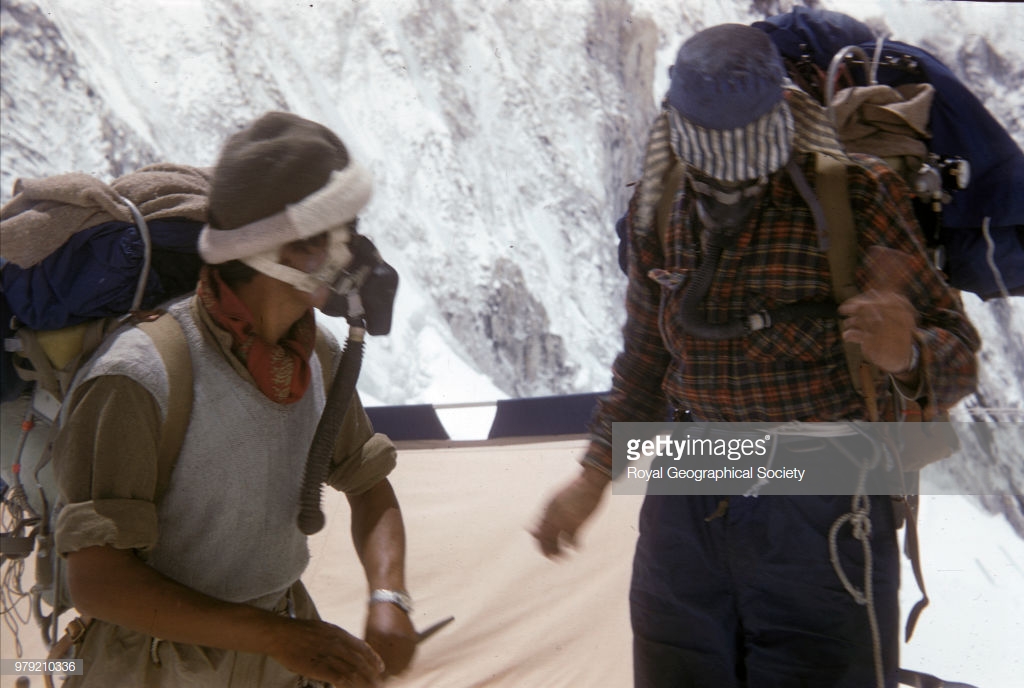
There are literally dozens of colour photographs that show him wearing an unambiguously steel watch on an equally steel bonklip style bracelet. There are also a few black and white ones of the same watch on the same strap that don't look remotely like a Rolex, but that's getting ahead of my argument.
It is at this point that things start to go downhill rapidly for Rolex. Unsurprisingly, there had been a great deal of interest in the expedition and some of our WIS forebears had, quite naturally and properly, taken an interest. This was expressed in the nearest thing that watch folk had to a watch forum at the time: the letters page of the BHI journal. It's here that I am indebted to Broussard for his stellar research and indeed the BNI and AHS for preserving such interesting information.
We join the 'thread' with a comment by a Mr C.E. Faller, in the August edition of the BHI Horological Journal who observed that:
Smiths claim that every member of the British Mount Everest Expedition was equipped with one of their watches. We also are aware that the Rolex Watch Co. claim that Colonel Hunt, Mr. Hillary and Sherpa Tensing wore Rolex Perpetual Oysters. Are we to presume that at least three members of the expedition wore one watch on each wrist?"
As it happens, at least three did: Hunt, Wylie and Bourdillon are all pictured in either the Everest film or the RGS pictures wearing both a Smiths and a Rolex. Hillary and Tenzing are not. Both wear the same watch consistently throughout the expedition. We'll return to what watch that was once we have addressed
what wasn't worn!
However, this barbed comment drew an unexpected response, from no other than D.W. Barrett, the then managing director of Smiths Clocks and Watches, as recorded in the September letters page:
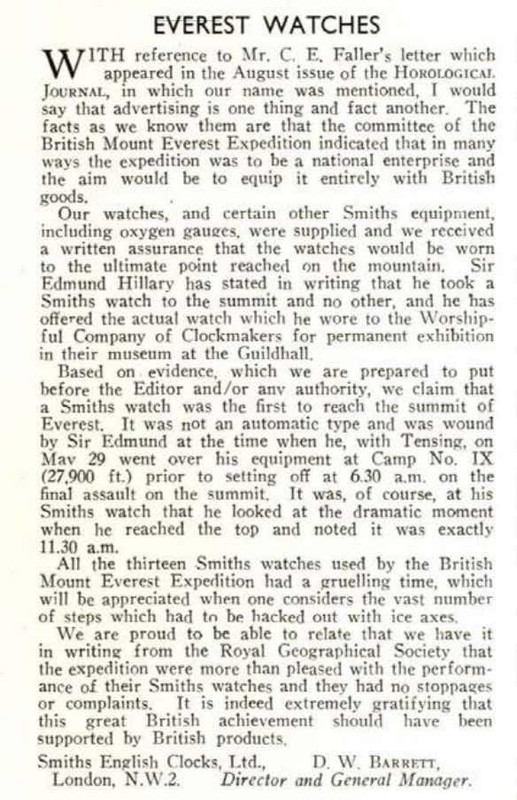
Now that is wonderfully unambiguous and leaves very little wriggle room. However, it also very much leaves the ball in Rolex's court. At this point, Rolex have all the advantages, the three men who are most in a position to counter this unambiguous claim by Smiths are Working with, or for, Rolex. Getting a Rolex to the top of Everest has been a decades long project for Rolex and it's simply beyond credibility that they haven't debriefed Hillary and Tenzing thoroughly. This would presumably include extended testimonials, pictures of watches, watches as potential museum exhibits and so on. At the very least, it means that Rolex, as an organisation, would be utterly unambiguously clear about precisely who wore what on the top of Everest. They had access to the principle players. They cared intensely about what happened and there was a great deal of pride and advertising capital at stake.
As a result, the letter that follows, from the managing director of Rolex (on page 651 of the October '53 edition of The BHI Horological Journal) comes as a bit of a surprise and it is this letter that I think proves the negative case:

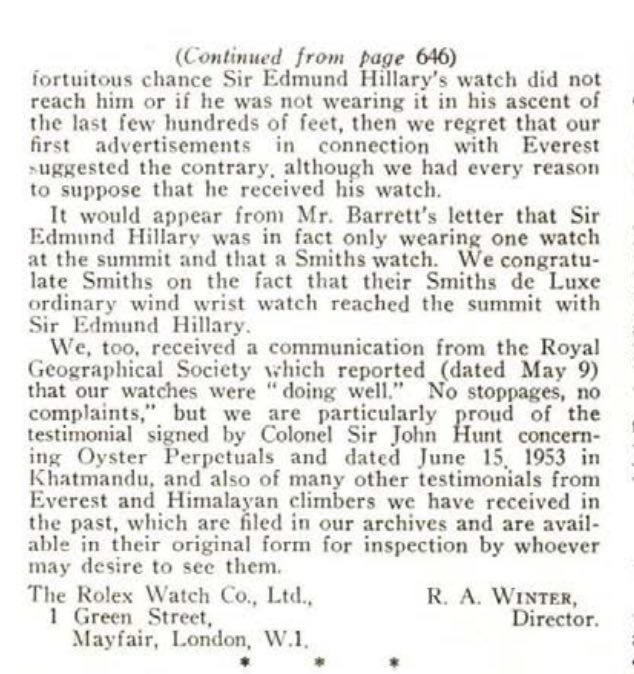
It is unthinkable that Rolex didn't look into this carefully and thoroughly before conceding the summit to Smiths. They'd been waiting decades, had assumed success and then had that success whipped from under them by a whisker.
That, for me, is the key evidence: The director of Rolex G.B. didn't believe that there was a Rolex on top of
Everest in 1953 and, in every advert that comes after that admission Rolex are scrupulous to never again claim explicitly that there was a Rolex on the summit in 1953. They certainly imply it incredibly strongly, but it is only in those few early adverts that the explicit claim of reaching the summit is made. This gives us a perfect example, if one was needed, of precisely how Rolex would behave if they thought that there was even the whisker of a chance that a Rolex had been on the Summit with Tenzing and Hillary.
This is bad enough, but the testimonial from Colonel Sir John Hunt is not something that Rolex should be proud of at all. It's something to be ashamed of. I've already demonstrated that this testimonial directly copies elements and themes from earlier adverts. Hunt's testimonial is dated June the fifteenth and reproduced in the advert above, but he very clearly didn't write it. Mind you, Mr Winter doesn't claim that he did, he merely claimed that Hunt signed it...
For that testimonial to be in Hunt's own words, he'd have to have written it, in the past tense, predicting the future performance of the team's Rolex, before he set off. Rolex must then have copied his words in their adverts because many of the words, phrases and sentiments found in it can be found in other Rolex adverts. Adverts that were in print before Hunt returned, like the one published in the Times on the second of June when literally no contact with Hunt was possible. This seems far fetched.
Returning to my main point, for there to have been a Rolex on the summit of Everest, either it was there without anyone realising or Hillary, Tenzing or Rolex must have decided to conceal that fact. Both Hillary and Tenzing became enthusiastic promoters of Rolex after the expedition. They'd have every motive to say there was and no reason to conceal a Rolex on the summit if one had been there. Likewise, the idea that Rolex wouldn't advertise the presence of a Rolex on the summit of Everest in 1953 if there had been one is literally unthinkable. They did it when they thought there was and they did it later when other expeditions reached the summit. Therefore, it is clear that neither Tenzing, nor Hillary nor Rolex believed there ever was a Rolex on the summit of Everest in 1953. No one is better placed to be sure about that.
That's got to put the matter well beyond all reasonable doubt.
As it is, the fact is that not only were Rolex pipped to the post by Smiths, but also, in 1956, by Enicar with their 'hamster ear' lugged Seapearl 600, precisely the same watch accepted by the US Navy when they rejected the Sub, but also by the Tianjin clock and watch company with the ZhuFeng (yup, it means Everest!) watches that equipped the 1960 Chinese team. It wasn't until a decade later that, finally, a Rolex was seen on top of Everest.
So that's the negative case. Thanks to Tribe125 for suggesting I posted something (and the odd inspirational Smiths) and Broker for his kind words and reputation. I hope this is a suitable return! Now I have stuff to do and will get on to the positive case later.
-
Post Thanks / Like - 1 Likes
 Tim.
Tim. liked this post
-
Mar 24, 2019, 12:08 AM
#13
So how about the positive case? This is simpler and requires a lot less typing.
I'll start with a simplifying assumption. Given that there is already solid written evidence that Hillary wore a Smiths A409 on the summit of Everest, a watch he gave to the Worshipful Company of Clockmakers and which has been in their collection ever since, I'll take that as a given. The question is what Norgay is wearing, as he is traditionally the person who wore a Rolex on the summit. I hope any reader is now clear that he didn't and so the question is what he wore.
The fortunate fact is that while the Rolex 6098 and the Smiths A409 are both about the same size and both have off white dials they are actually quite distinct watches.
 Looking at the two from the side and an angle note the way that the Rolex lugs have far more curve and taper to almost a point while the Smiths is blunt. Also note the way the light reflects of the polished sides of the Rolex and the brushed sides of the Smiths.
Looking at the two from the side and an angle note the way that the Rolex lugs have far more curve and taper to almost a point while the Smiths is blunt. Also note the way the light reflects of the polished sides of the Rolex and the brushed sides of the Smiths.
Here's Alfred Gregory's Rolex from directly ahead:
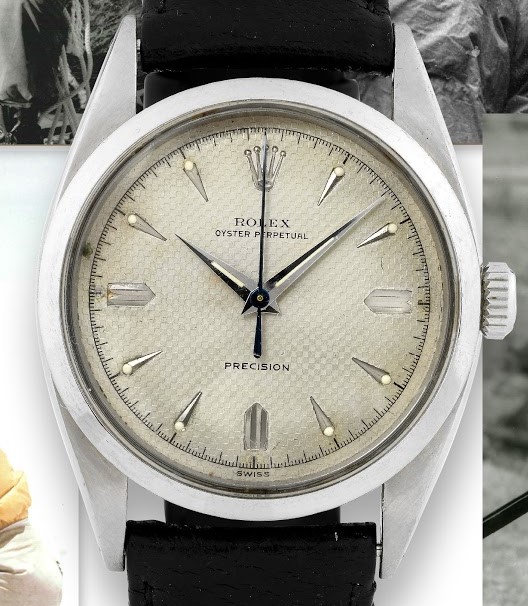
And here's Hillary's A409:
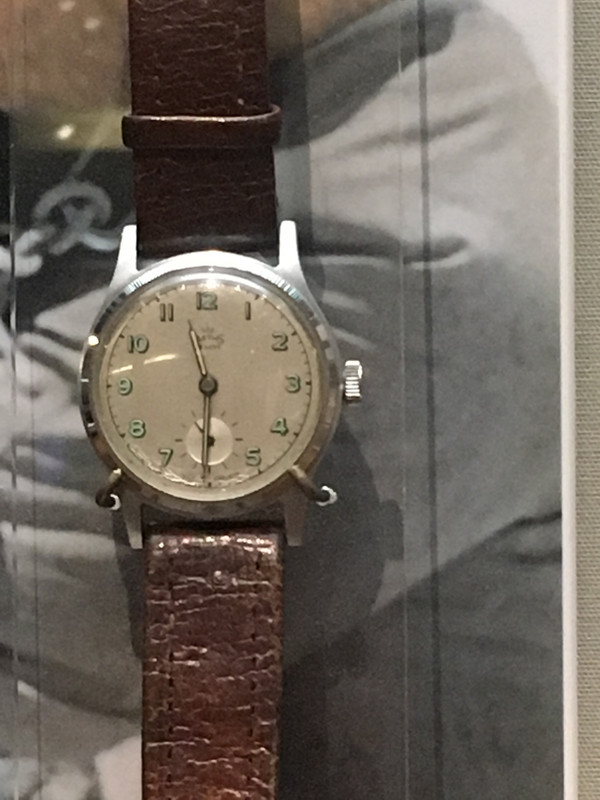
Here's a deliberately fuzzed up picture of my Smiths and Rolex that are closest to these two:
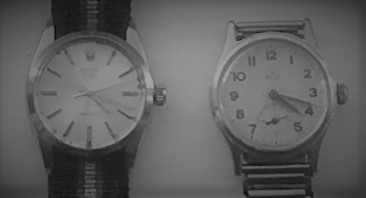
And, moving a step further, here's the two in exactly the sort of grainy picture that forms the main body of the RGS archives:
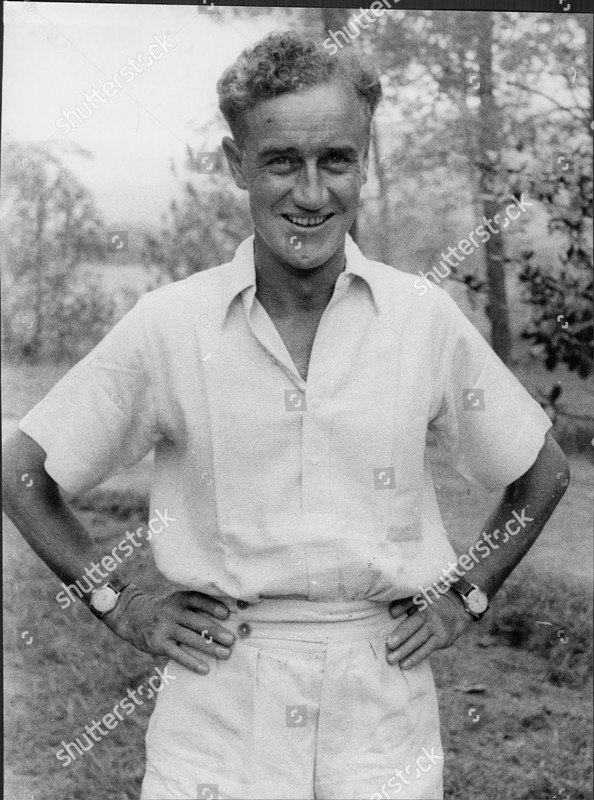
I assume that, looking at the wrists of Charles Wylie, when he is wearing both it is clear that the Smiths is on the left of the picture, that is, his right hand and the Rolex is to the right of the picture.
So, I hope that's a satisfactory introduction to the sorts of differences between the two watches that are potentially going to be obvious in a grainy picture. I'm not intending to claim that any single photograph is, of itself a smoking gun. What I want to argue is that there is a single watch worn by Tenzing while on Everest and it's possible to establish a connection between all the watches based upon the rather specific bamboo style bracelet it is attached to.
Take this picture:
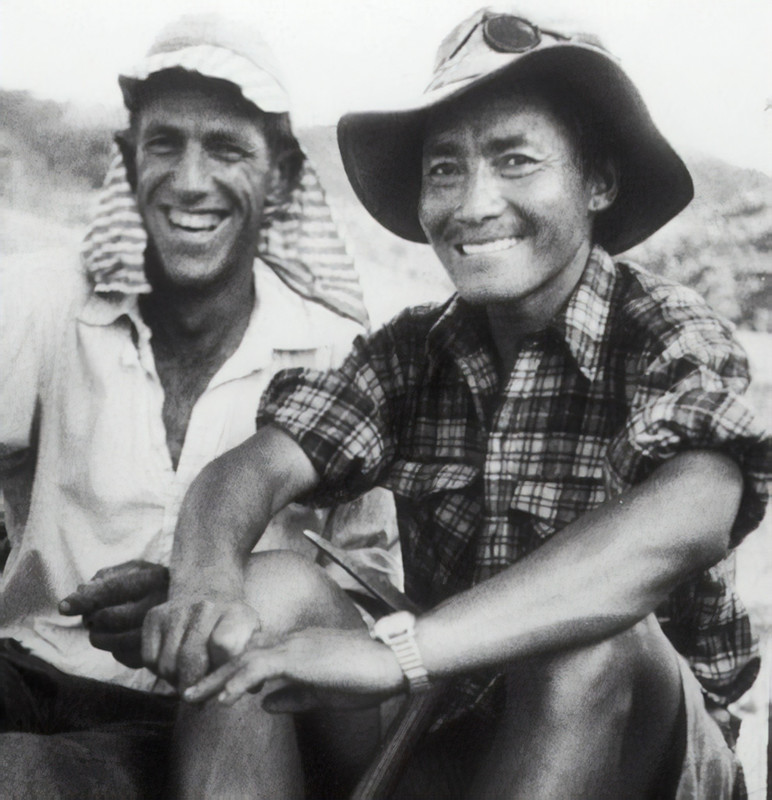
Now this is just at the point where it could be either. However what is more interesting is the way that the bracelet is hanging. About five rungs down you can see an odd change in shape. Now I'm just sad enough to have a fair few of these Bonklip style 'bamboo' bracelets and so I worked my way through my collection until I found one that hung just right, like so:

It just so happens it's the standard bracelet for a West End Watch co watch, fitted to their 'Sowar' range. these were standard issue to the Indian Army from the late thirties onwards. Tenzing served in the British Indian Army's Mountain artillery during WWII (as a batman). While West End are largely unheard of in the West that is precisely because they focussed on the East. They used a variation of the Taubert decagon case and are remarkably robust.
So now there's a specific bracelet linking all the irritatingly blurry images in which it features. And that's rather a lot. From early in the expedition:
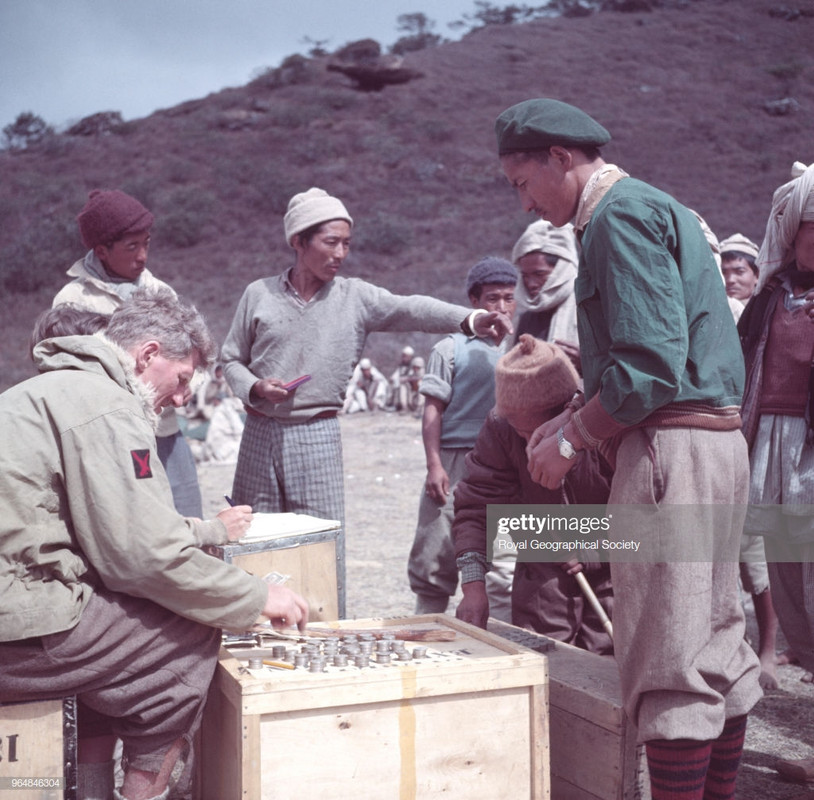
Close up:
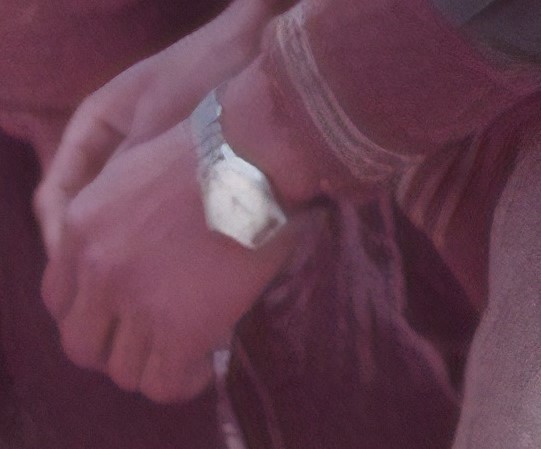
to the moment they set off for the summit:

Sometimes one feature is obvious, in this case the brushed finish:
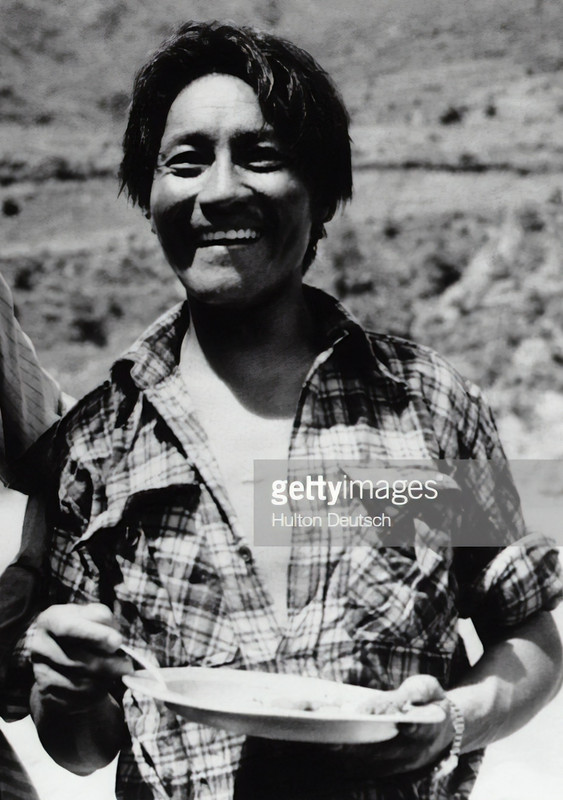
In another the way the lug joins the case:
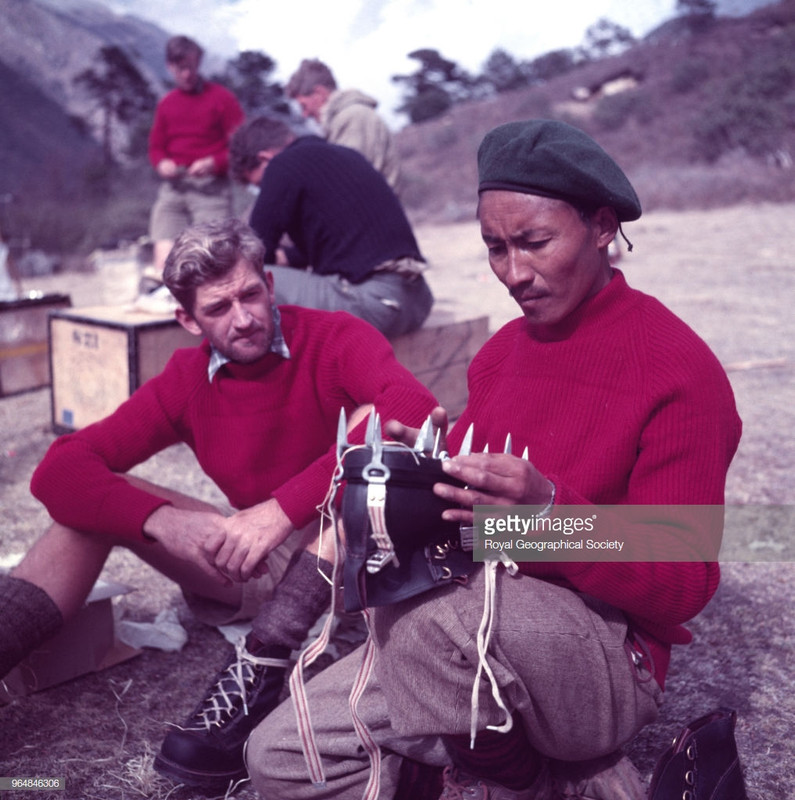
It's perfectly true that it isn't always obvious that it's the A409 or the bracelet, but in the pictures I've shown it's obvious that it's one or the other. Now it's possible that Norgay had two watches both on a West End bracelet and just by coincidence he was always wearing the other one in the picture where it isn't clear, but that seems increasingly unlikely the more images from the expedition you look at.
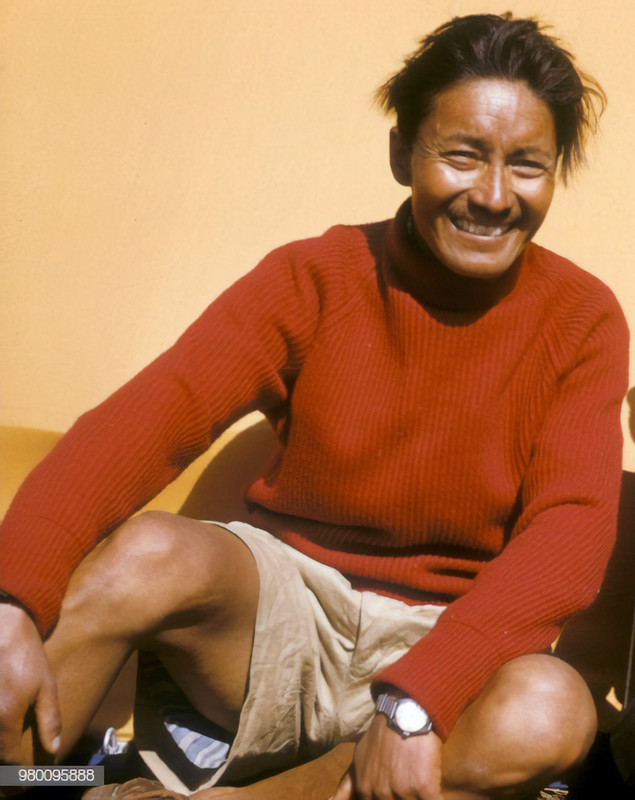

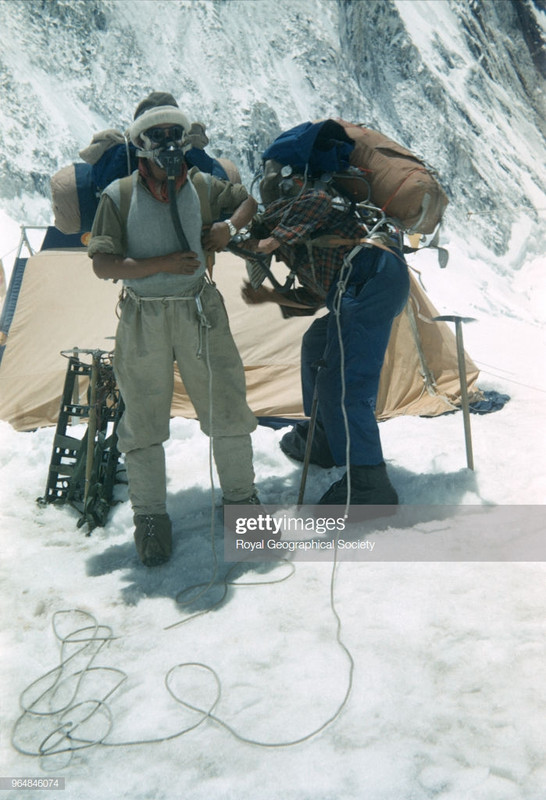
Which brings me to as close as I'm going to get to a smoking gun:

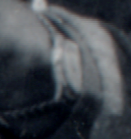
Compare this to Hillary's watch in The Science Museum:
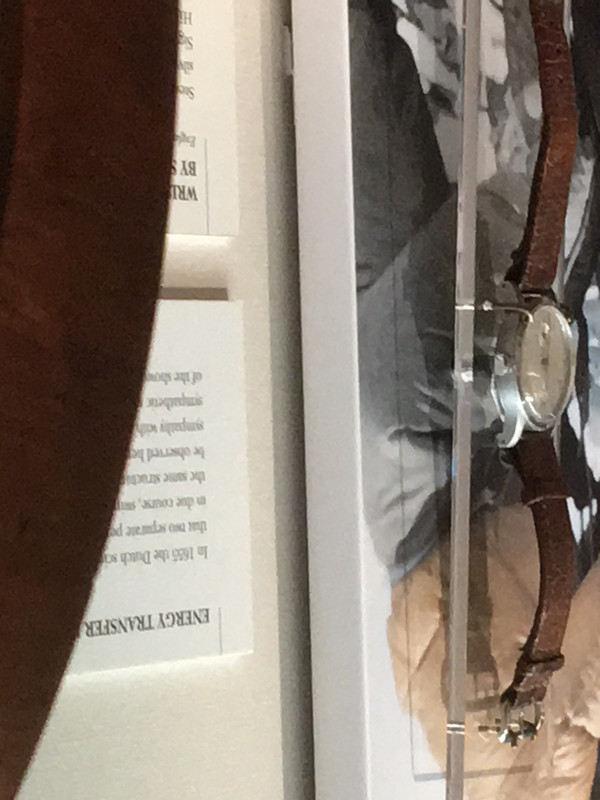
That's it really. When I look at the totality of the images I'm left quite certain that the watch in question is a Smiths A409 worn loosely on a bamboo bracelet sometimes it looks larger or smaller but when you think about it, it isn't. I think the case for what wasn't worn is bulletproof, but the case for what was really worn comes down to what you see. To me, that looks clear and obvious. but that's about as good as it gets I'm afraid.
Finally, just to demonstrate the difference, Here are the pictures of Evans and Bourdillon immediately after their return to the South Col:
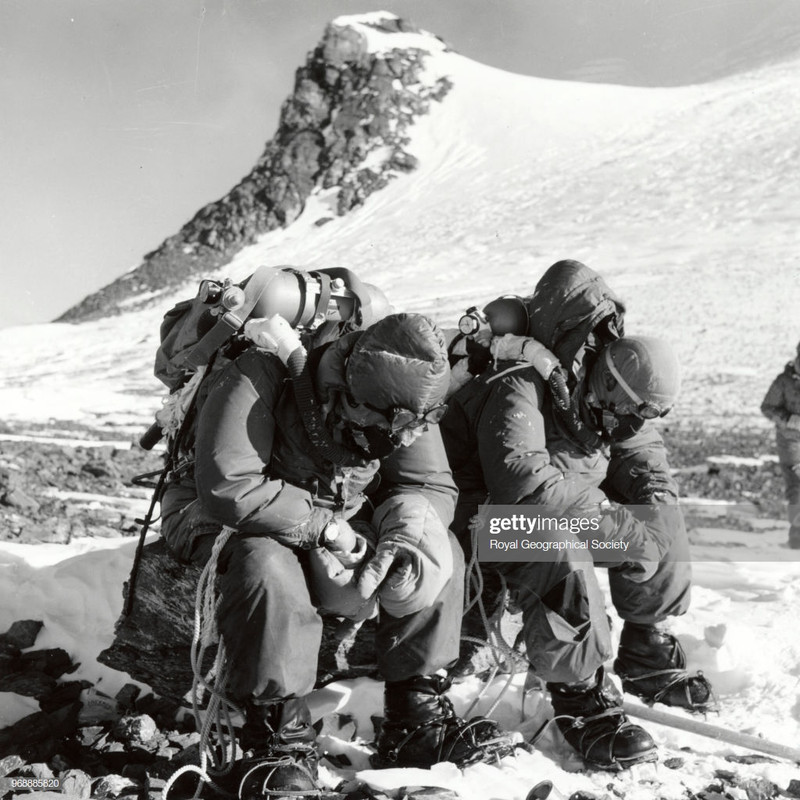

If they hadn't decided to change their cylinders early and got ice in Evan's system, these would probably be the smoking gun for Rolex...
But if you really can't get enough Everest, there's always this:
http://www.dreamwanderlust.com/artic...-2017-20170529
-
Post Thanks / Like - 1 Likes
 Tim.
Tim. liked this post
-
Jan 24, 2021, 03:42 PM
#14
Shout it from the highest hill - Matt’s Everest research heard across the world -
https://quillandpad.com/2021/01/23/m...yths-debunked/
Last edited by tribe125; Jan 24, 2021 at 10:21 PM.
-
Post Thanks / Like - 2 Likes
 Likes: 33
Likes: 33
 Matt liked this post
Matt liked this post

Originally Posted by The Times June 2nd '53
As if that wasn't bad enough, Hunt had never been on an Everest expedition before. He had applied for one but been turned down. As such all the talk of previous experiences on Everest seems slightly inauthentic to say the least. The most likely explanation was that the copy was written for him and he merely signed off on it. The other possibility was that he simply copied earlier Rolex adverts. The degree of similarity between Hunt's words and earlier adverts is far too great for any possible coincidence.Originally Posted by Col. Hunt Kathmandu June 15th '53
 Tim. liked this post
Tim. liked this post
Looking at the two from the side and an angle note the way that the Rolex lugs have far more curve and taper to almost a point while the Smiths is blunt. Also note the way the light reflects of the polished sides of the Rolex and the brushed sides of the Smiths.

 Tim. liked this post
Tim. liked this post